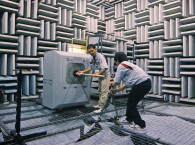
Low-Profile Loudspeaker Transducer
Patent Number: 9,467,783
Inventors: George Bullimore (Vale of Glamorgan, GB)
Assignee: Tymphany Worldwide Enterprises, Ltd.(Grand Cayman, KY)
Filed: Oct 25, 2013
Current CPC Class: H04R 7/16 (20130101)
Granted: October 11, 2016
Number of Claims: 10
Number of Drawings: 27
Abstract from Patent
A low-profile loudspeaker transducer is presented with an arrangement of placing the motor up near or into the inside concave portion of a convex dome or inverted convex cone diaphragm. In some preferred embodiments, the low-profile structure is facilitated by an inverted placement of the spider suspension above the plane of the surround suspension to stabilize the voice coil during excursion while supporting a low profile structure. Additionally, in numerous embodiments a coupling structure is utilized between the voice coil former and the diaphragm to create a broad surface area connection to the diaphragm to create a stiffer structure and minimizing breakup modes and creating a more robust mechanical structure to withstand greater output capability.
Independent Claims
1. A low-profile loudspeaker transducer, comprising: a magnet; a top plate disposed above the magnet; a voice coil former having a first end which terminates above the top plate; a diaphragm extending over the top plate; a coupler connecting the diaphragm to the first end of the voice coil former; a first suspension disposed beneath the diaphragm and affixed at one end to the diaphragm and at a second end to the top plate; and a second suspension extending from an outer edge of the diaphragm to a frame of the loudspeaker transducer.
Reviewer Comments
The patent discloses a low-profile transducer with a simple and effective assembly (see Figures 1-4), which can maintain the diaphragm surface area and displacement of the conventional-sized transducers while significantly reducing the device’s front-to-back depth. In a preferred embodiment the low-profile loudspeaker transducer may incorporate a reversed relationship between the surround suspension and the spider suspension with the spider suspension placed forward of the surround suspension and housed within the volume of the projecting dome or inverted cone diaphragm, enabling a shallower structure while maintaining stability and reducing rocking of the voice coil in the voice coil gap during diaphragm excursions.
In many of the preferred embodiments, a coupling member acts as an intermediate connector between the voice coil former and the diaphragm, providing an increased contact surface area attachment and support to the diaphragm than would result from a direct contact coupling of the voice coil and diaphragm, as seen in the prior art.




The inventor, George Bullimore, currently a senior transducer engineer at Tymphany previously developed transducers for Harman International. Those interested in the design of these types of devices may find it interesting to see the evolution of his work by reviewing his previous patent, US Patent 8,842,873, “Loudspeaker with Inverted Motor,” assigned to Harman Becker Automotive Systems, which incorporates similar concepts (not sited as prior art in the current patent). Readers will also find US Patent 8,638,968 “Low-Profile Loudspeaker Driver and Enclosure Assembly,” by inventor Timothy A. Gladwin, assigned to DEI Headquarters, Inc., to be an interesting read, as it contains drawings that appear to be structurally similar to the current invention (also, not sited as prior art in the current patent).
Other patents which are interesting for studying alternative approaches to this type of low-profile device are: US 7570776, US 7236607, US 5511131, US Application 2007/0189571, US Application 2010/0183187, US Application 2006/0120555, and US Application 2005/0276435. While many prior art devices of this type have minimal X-max and are often limited to being used as a wideband midrange, the current invention can be configured for substantial excursion and operated as a wideband woofer system.
One can view the specifications of actual units, which have been reduced to practice as production devices, at the Tymphany Peerless website where units have been developed with FS as low as 38 Hz and some with smooth response to beyond 4 kHz. As a larger diaphragm diameter, low-profile dome woofer—partially due to the broad contact area of the novel intermediate coupling structure between the voice coil and diaphragm—Tymphany appears to have managed upper range breakup modes more effectively than previous devices of this type. It is interesting that the aluminum cone diaphragm units have a smoother response through the breakup range than the paper cone versions, which is the opposite of what is often the case with standard cone diaphragm woofer/midrange devices.
The patent includes numerous configurations beyond what has been produced to date including as a variety of voice coil to diaphragm coupling means or as a compliant mechanical or pneumatic coupling structure that can provide a low-pass mechanical filter and/or a further minimization of the effect of breakup modes of the moving structure. Additionally, as shown in Figure 3 (referred to as Figure 8 in the patent), the transducer can be configured as a two-way coaxial device.
As with many larger, wide bandwidth, prior art transducers with dome diaphragms, the sensitivity tends to be on the lower side, at least with the first-generation production units, with a “claimed” sensitivity in the range of approximately 81.8 to 85.8 dB. All in all, the new architecture appears to be promising and worth watching as it is further refined over time.
Editor’s Note: Vance Dickason characterized the Tymphany GBS-135F25AL02-04 in the Test Bench column of Voice Coil’s September 2016 issue. Read it online here.
This article was originally published in Voice Coil, May 2017.






